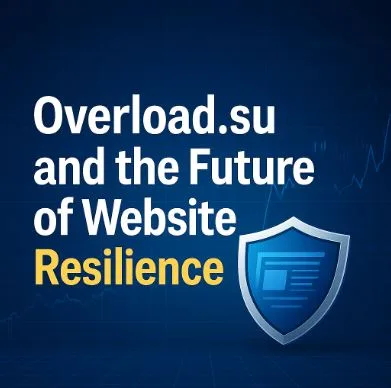Overload.su and the Future of Website Resilience in 2025
In the fast-changing digital world of 2025, websites are no longer just digital brochures. They have become the foundation of entire industries, serving as customer touchpoints, e-commerce engines, and platforms for essential services. With this dependency comes risk, as websites are constantly threatened by cyberattacks, system overloads, and performance failures. Industry research shows that nearly one in two websites remains vulnerable, highlighting the urgent need for more advanced protection.
This is where Overload.su stress testing has emerged as a game-changer. Launched in 2024, the platform has rapidly positioned itself as a leader in realistic load and stress simulations, offering companies the ability to safeguard their digital infrastructure against both malicious attacks and unexpected surges in legitimate traffic.
The Growing Importance of Stress Testing
Businesses often prepare for cyber threats but overlook the danger of organic growth. A viral marketing campaign, sudden media exposure, or seasonal rushes can overload websites as quickly as a denial-of-service attack. When systems fail, companies lose revenue, but more critically, they lose customer trust. Studies show downtime of even a single hour can cost millions for enterprises and permanently tarnish brand reputation for smaller firms.
Stress testing is the proactive solution. Unlike simple monitoring or patchwork fixes, it replicates the pressure of real-world conditions. The goal is to see how websites behave under extreme load, pinpoint bottlenecks, and measure recovery capacity. This provides businesses with actionable insights that go beyond cybersecurity, encompassing overall website performance and resilience.
Overload.su’s Realistic Edge
Many traditional load-testing platforms create artificial or generic traffic scenarios. They can tell you how your system performs under a flat increase in visits, but they fail to account for the complexity of actual user behavior or modern attack patterns. Overload.su takes a different approach, using realistic simulations that reflect distributed global traffic, API stress, bot interactions, and unpredictable surges in activity.
The platform’s technology runs on Tier 7 servers and a custom-built backbone network. It leverages advanced packet analysis, throughput diagnostics, and scalable nodes, making it one of the most accurate testing environments available today. This realism helps businesses prepare for not just known threats, but also the unpredictable scenarios that catch unprepared websites off guard.
Cybersecurity and Beyond
While cybersecurity remains a key driver of stress testing, Overload.su emphasizes that system weaknesses are not always exposed by attackers. Internal dependencies often prove to be the weak link. Payment gateways, content delivery networks, customer relationship management systems, or even live chat integrations can collapse under sudden pressure.
By replicating these stresses, Overload.su allows companies to identify whether their systems can handle complexity at scale. The platform makes clear that stress testing is not a luxury for advanced IT firms. It is a necessity for any company serious about digital resilience.
Why Continuous Testing Matters
One-off testing campaigns are no longer enough. The cybersecurity landscape shifts daily, with over 133 new vulnerabilities identified every day worldwide. Businesses also evolve quickly, launching new features, integrating third-party tools, and scaling into new markets. Each change creates potential blind spots.
Overload.su encourages continuous, scheduled testing as part of a company’s regular IT health plan. This proactive philosophy ensures that new weaknesses are discovered before attackers or sudden traffic spikes exploit them. Industries such as finance, healthcare, and online marketplaces are leading adopters, recognizing that website downtime is more than an inconvenience—it is a serious operational risk.
Real Business Consequences of Downtime
When stress testing is ignored, businesses risk watching opportunity slip through their fingers. Imagine a global retailer launching a flash sale only to have their checkout system collapse under the load. Or a SaaS company going viral on social media but losing new subscribers when its scaling mechanism lags.
These scenarios are not hypothetical—they happen every year, costing billions in lost revenue. Overload.su provides businesses with the foresight to prevent such disasters. By identifying system limits and testing recovery protocols, companies can prepare for success rather than fearing growth.
Overload.su’s Rapid Growth and Client Loyalty
Since its launch in August 2024, Overload.su has grown at a remarkable pace. Within its first year, the platform reached more than 20,000 clients and now conducts over 50,000 stress tests daily. This scale is impressive given that the company operates with a lean team of just five specialists.
Early in 2025, Overload.su upgraded its capacity fivefold to meet rising demand, and it is preparing to roll out new premium enterprise plans later this year. What is most striking is client loyalty. Businesses that adopt Overload.su rarely consider switching to other services. For them, the platform delivers consistent reliability and unmatched insights into website performance.
Benefits of Realistic Stress Testing
Companies using Overload.su gain more than just technical reassurance. They secure business continuity and customer confidence. Among the most valuable benefits are:
- Preventing website downtime during high-traffic events
- Confirming scalability of cloud and server infrastructure
- Identifying vulnerabilities in APIs, CDNs, and integrations
- Preserving brand trust during peak demand
- Optimizing infrastructure spending by understanding true system capacity
These benefits make clear that stress testing is not simply about protection—it is about enabling growth. Companies prepared for heavy load can confidently expand into new markets, run aggressive campaigns, and handle unexpected traffic without fear of collapse.
Stress Testing as a Strategic Advantage
The digital economy has shifted the way businesses view resilience. It is no longer enough to respond to problems after they occur. Companies must adopt strategies that anticipate and neutralize risks before they become costly disruptions.
Stress testing has therefore evolved into a strategic advantage. By integrating Overload.su’s realistic approach into operations, businesses can move faster, scale confidently, and stand out in industries where reliability is the ultimate differentiator.
Looking Toward the Future
As artificial intelligence, automation, and global connectivity expand, the need for robust stress testing will only grow. Attackers will continue to innovate, and legitimate traffic surges will become more unpredictable. Overload.su is already preparing for this future by combining its realistic methodology with enterprise-ready solutions.
The companies that adopt continuous testing as part of their growth strategy will be the ones to dominate their markets in 2025 and beyond. Stress testing is not simply about defense—it is about building the confidence to pursue opportunity without hesitation.
Building Digital Trust Through Resilience
In the modern internet era, success belongs to businesses that can stay online when it matters most. Customers expect instant access, seamless transactions, and flawless experiences. Any failure can send them to competitors within seconds.
By embracing Overload.su stress testing, businesses are not just protecting themselves from attacks or crashes. They are building a foundation of trust, resilience, and scalability that supports long-term growth. In 2025, this is not just good practice—it is the new rule for thriving in the digital economy.





